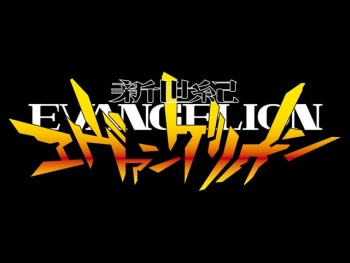Neon Genesis Evangelion: Difference between revisions
The wayneiac (talk | contribs) (Added title explanation.) |
(Found episode list.) |
||
| (20 intermediate revisions by 9 users not shown) | |||
| Line 1: | Line 1: | ||
[[File:Neon Genesis Evangelion logo.jpg|right|350px|thumb|Neon Genesis Evangelion logo.]]'''Neon Genesis Evangelion''' (新世紀エヴァンゲリオン) is a 26-episode anime that ran on Japanese television from Dec. 4, 1995, to March 27, 1996. Produced by [[Gainax]], written and directed by Hideaki Anno. It involves a 14-year-old boy, [[Shinji Ikari]], summoned by his long-absent father, [[Gendo Ikari]], to pilot a bio-mechanical being known as an [[Evangelion]], or Eva for short. His task is to battle mysterious beings known as [[Angels]], who are somehow known to be due to begin their attacks soon, set fifteen years after a world-wide cataclysm known as [[Second Impact]]. | |||
The series explores the experiences and emotions of other Evangelion pilots and members of [[Nerv]] as they attempt to prevent another catastrophe. Evangelion is one of the most successful and critically acclaimed anime television series of the 1990s. Considered both a critique and a deconstruction of the mecha genre. The series has become a cultural icon, and influenced an artistic and technical revival of the anime industry. | |||
After the end of the television series, there were two Evangelion movies: ''[[Evangelion: Death and Rebirth|Neon Genesis Evangelion: Death & Rebirth]]'', and ''[[The End of Evangelion|Neon Genesis Evangelion: The End of Evangelion]]''. ''Death and Rebirth'' starts as a compilation of footage from the series, (not a condensation, but instead categorized by character). The remainder is part of the first half of ''End of Evangelion''. Originally intended to be one long movie, but deadline problems forced the studio to release it as two movies. The most recent Japanese video release of the first movie includes only the compilation footage, ''Death,'' because all of ''Rebirth'' is included in ''The End of Evangelion''. ''The End of Evangelion'' is a retelling of, and an expansion upon, the events in the last two episodes of the TV series. EOE clarifies the meaning of the abstract ending seen on TV, and may be intended to compliment it'' [[EoTV vs EoE|without changing it significantly]]''. | |||
== | ==Production== | ||
Evangelion was written and directed by [[Hideaki Anno]], with | [[File:Hideaki Anno.jpg|thumb|right|Hideaki Anno: Series creator|120px]] | ||
Evangelion was written and directed by [[Hideaki Anno]], with character design by [[Yoshiyuki Sadamoto]] and mechanical design by Anno and Ikuto Yamashita. Anno fell had become deeply depressed following completion of his work on ''Nadia: The Secret of Blue Water''. According to Yasuhiro Takeda, Anno agreed to a collaboration between King Records and Gainax while drinking with a King representative. King Records guaranteed Anno a time slot for "something, anything". Anno began development of the new series in 1993 around the notion of "not running away". In the early design phase of the Evangelion project several formats were considered; including a film, a television series and an original video animation (OVA) series. The producers finally opted for the television series as it was the most widely accessible media in Japan at that time. | |||
Evangelion suffers from a noticeable gradual decrease in animation quality, to the point of infamy. As production of the series progressed, more and more of the long term budget disappeared causing a number of animation tricks to be implemented in order to cut corners. These included: recycled shots, long distance shots, covering lip flaps with hands or clipboards, and 1 minute shots of static images. | |||
The development of the Neon Genesis Evangelion series ran close to deadlines throughout its production run. The initial cuts of the first two episodes were screened at the second Gainax festival in July 1995, only three months before they were aired on television. By episode 13 the series began to deviate significantly from the original story, and the initial script was abandoned. The number of Angels was reduced to 17 instead of the an originally planned 28, and the writers changed the story's ending, which had originally described the failure of the Human Instrumentality Project after an Angel attack from the moon. Starting with episode 16, the show changed drastically, focusing on the characters and discarding the grand narrative concerning salvation for a narrative focusing on the individual characters. This change coincided with Anno's development of an interest in psychology after a friend lent him a book on mental illness. This focus culminated in a psychoanalysis of the characters in the two final episodes. The production ran so close to the airing deadline that the completed scenes used in the preview of the twenty-fifth episode had to be redesigned to work with the new ending. These episodes feature heavy use of abstract animation, flashbacks, simple line drawings, photographs and fixed image scenes with voice-over dialogue. Some critics speculated that these unconventional animation choices resulted from budget cuts, but Toshio Okada stated that they were the result of the ending being decided only three months before airing.[http://en.wikipedia.org/wiki/Neon_Genesis_Evangelion#Production 1] | |||
The actual Japanese title is '''Shin Seiki Evangelion''', a hybrid Japanese-Greek title which means "''Gospel of the New Century''". The title '''Neon Genesis Evangelion''' is all Greek, and means "''Gospel of the New Genesis''". However, this is not a case of the English-language | |||
By the end of the series, whether it be out of desperation or artistic license, [[Episode_25|episodes 25]] and [[Episode_26|26]] become minimalist and introspective look at the characters with little to no direct continuation of the external action orientated story. The release of [[The End of Evangelion]] provided an alternative, animation heavy ending. | |||
===Episodes and Films=== | |||
{{Episode List}} | |||
==Notes== | |||
The actual Japanese title is '''Shin Seiki Evangelion''', a hybrid Japanese-Greek title which means "''Gospel of the New Century''". The title '''Neon Genesis Evangelion''' is all Greek, and means "''Gospel of the New Genesis''". However, this is not a case of the English-language distributors messing with the translation. '''Neon Genesis Evangelion''' is the official English title, chosen by the series' Japanese creators. | |||
==External Links== | |||
http://en.wikipedia.org/wiki/Neon_Genesis_Evangelion#Production. | |||
[[Category:A to Z]] | |||
Latest revision as of 20:30, 25 December 2014

Neon Genesis Evangelion (新世紀エヴァンゲリオン) is a 26-episode anime that ran on Japanese television from Dec. 4, 1995, to March 27, 1996. Produced by Gainax, written and directed by Hideaki Anno. It involves a 14-year-old boy, Shinji Ikari, summoned by his long-absent father, Gendo Ikari, to pilot a bio-mechanical being known as an Evangelion, or Eva for short. His task is to battle mysterious beings known as Angels, who are somehow known to be due to begin their attacks soon, set fifteen years after a world-wide cataclysm known as Second Impact.
The series explores the experiences and emotions of other Evangelion pilots and members of Nerv as they attempt to prevent another catastrophe. Evangelion is one of the most successful and critically acclaimed anime television series of the 1990s. Considered both a critique and a deconstruction of the mecha genre. The series has become a cultural icon, and influenced an artistic and technical revival of the anime industry.
After the end of the television series, there were two Evangelion movies: Neon Genesis Evangelion: Death & Rebirth, and Neon Genesis Evangelion: The End of Evangelion. Death and Rebirth starts as a compilation of footage from the series, (not a condensation, but instead categorized by character). The remainder is part of the first half of End of Evangelion. Originally intended to be one long movie, but deadline problems forced the studio to release it as two movies. The most recent Japanese video release of the first movie includes only the compilation footage, Death, because all of Rebirth is included in The End of Evangelion. The End of Evangelion is a retelling of, and an expansion upon, the events in the last two episodes of the TV series. EOE clarifies the meaning of the abstract ending seen on TV, and may be intended to compliment it without changing it significantly.
Production

Evangelion was written and directed by Hideaki Anno, with character design by Yoshiyuki Sadamoto and mechanical design by Anno and Ikuto Yamashita. Anno fell had become deeply depressed following completion of his work on Nadia: The Secret of Blue Water. According to Yasuhiro Takeda, Anno agreed to a collaboration between King Records and Gainax while drinking with a King representative. King Records guaranteed Anno a time slot for "something, anything". Anno began development of the new series in 1993 around the notion of "not running away". In the early design phase of the Evangelion project several formats were considered; including a film, a television series and an original video animation (OVA) series. The producers finally opted for the television series as it was the most widely accessible media in Japan at that time.
Evangelion suffers from a noticeable gradual decrease in animation quality, to the point of infamy. As production of the series progressed, more and more of the long term budget disappeared causing a number of animation tricks to be implemented in order to cut corners. These included: recycled shots, long distance shots, covering lip flaps with hands or clipboards, and 1 minute shots of static images.
The development of the Neon Genesis Evangelion series ran close to deadlines throughout its production run. The initial cuts of the first two episodes were screened at the second Gainax festival in July 1995, only three months before they were aired on television. By episode 13 the series began to deviate significantly from the original story, and the initial script was abandoned. The number of Angels was reduced to 17 instead of the an originally planned 28, and the writers changed the story's ending, which had originally described the failure of the Human Instrumentality Project after an Angel attack from the moon. Starting with episode 16, the show changed drastically, focusing on the characters and discarding the grand narrative concerning salvation for a narrative focusing on the individual characters. This change coincided with Anno's development of an interest in psychology after a friend lent him a book on mental illness. This focus culminated in a psychoanalysis of the characters in the two final episodes. The production ran so close to the airing deadline that the completed scenes used in the preview of the twenty-fifth episode had to be redesigned to work with the new ending. These episodes feature heavy use of abstract animation, flashbacks, simple line drawings, photographs and fixed image scenes with voice-over dialogue. Some critics speculated that these unconventional animation choices resulted from budget cuts, but Toshio Okada stated that they were the result of the ending being decided only three months before airing.1
By the end of the series, whether it be out of desperation or artistic license, episodes 25 and 26 become minimalist and introspective look at the characters with little to no direct continuation of the external action orientated story. The release of The End of Evangelion provided an alternative, animation heavy ending.
Episodes and Films
| Episodes & Films | |
| Television Series | Episode 01 | Episode 02 | Episode 03 | Episode 04 | Episode 05 | Episode 06 Episode 07 | Episode 08 | Episode 09 | Episode 10 | Episode 11 | Episode 12 | Episode 13 |
| Movies | Death | Rebirth |
| Rebuild of Evangelion | Evangelion 1.0 | Evangelion 2.0 | Evangelion 3.0 | (-46h) | (-120min) | Evangelion: 3.0 + 1.0 |
Notes
The actual Japanese title is Shin Seiki Evangelion, a hybrid Japanese-Greek title which means "Gospel of the New Century". The title Neon Genesis Evangelion is all Greek, and means "Gospel of the New Genesis". However, this is not a case of the English-language distributors messing with the translation. Neon Genesis Evangelion is the official English title, chosen by the series' Japanese creators.
External Links
http://en.wikipedia.org/wiki/Neon_Genesis_Evangelion#Production.
